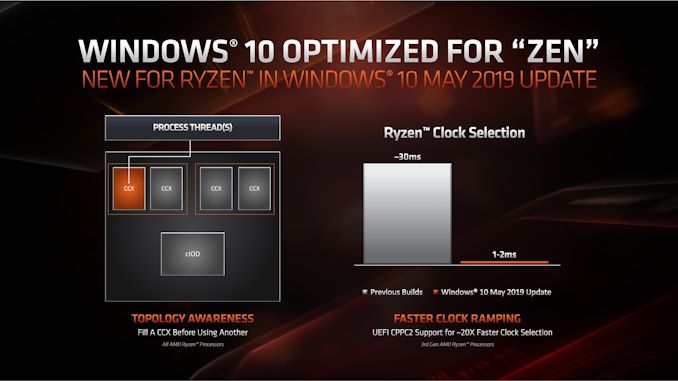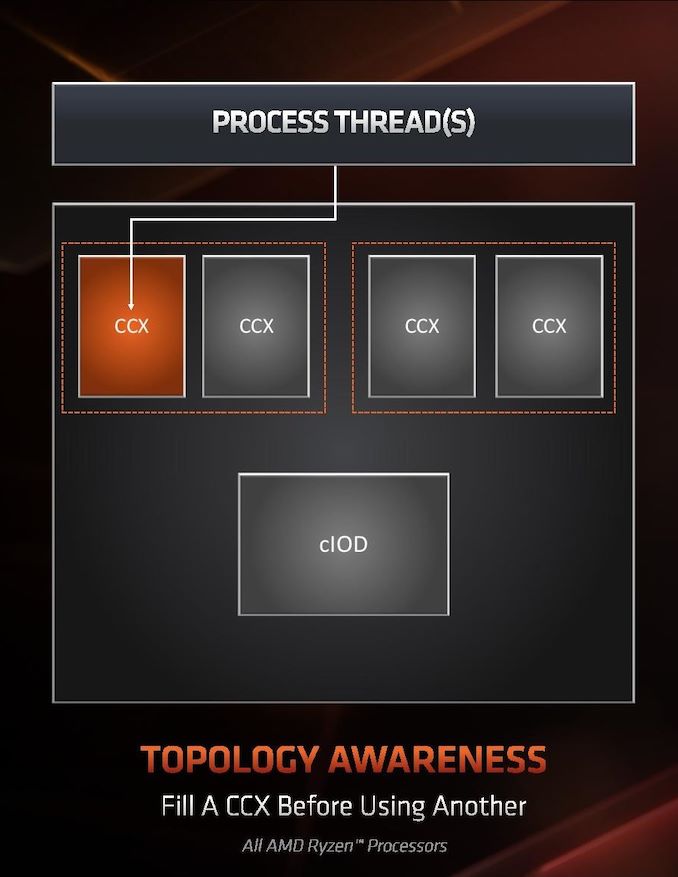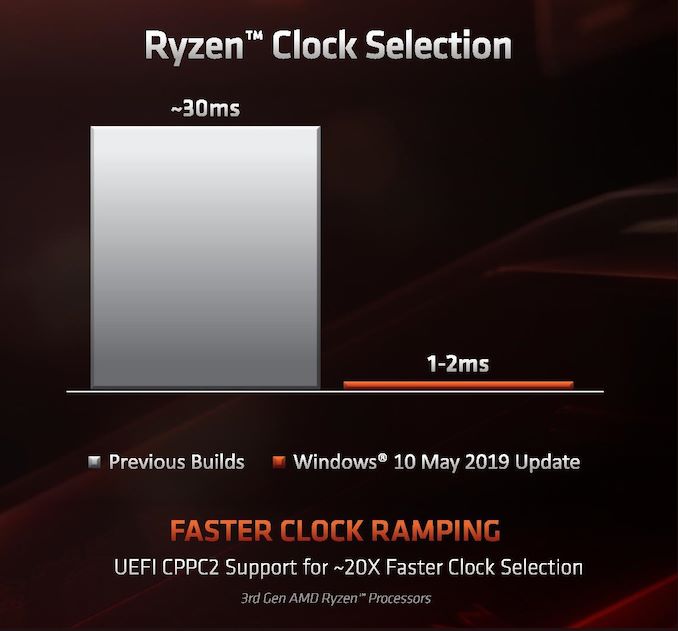The AMD 3rd Gen Ryzen Deep Dive Review: 3700X and 3900X Raising The Bar
by Andrei Frumusanu & Gavin Bonshor on July 7, 2019 9:00 AM ESTSection by Dr. Ian Cutress (Orignal article)
Windows Optimizations
One of the key points that have been a pain in the side of non-Intel processors using Windows has been the optimizations and scheduler arrangements in the operating system. We’ve seen in the past how Windows has not been kind to non-Intel microarchitecture layouts, such as AMD’s previous module design in Bulldozer, the Qualcomm hybrid CPU strategy with Windows on Snapdragon, and more recently with multi-die arrangements on Threadripper that introduce different memory latency domains into consumer computing.
Obviously AMD has a close relationship with Microsoft when it comes down to identifying a non-regular core topology with a processor, and the two companies work towards ensuring that thread and memory assignments, absent of program driven direction, attempt to make the most out of the system. With the May 10th update to Windows, some additional features have been put in place to get the most out of the upcoming Zen 2 microarchitecture and Ryzen 3000 silicon layouts.
The optimizations come on two fronts, both of which are reasonably easy to explain.
Thread Grouping
The first is thread allocation. When a processor has different ‘groups’ of CPU cores, there are different ways in which threads are allocated, all of which have pros and cons. The two extremes for thread allocation come down to thread grouping and thread expansion.
Thread grouping is where as new threads are spawned, they will be allocated onto cores directly next to cores that already have threads. This keeps the threads close together, for thread-to-thread communication, however it can create regions of high power density, especially when there are many cores on the processor but only a couple are active.
Thread expansion is where cores are placed as far away from each other as possible. In AMD’s case, this would mean a second thread spawning on a different chiplet, or a different core complex/CCX, as far away as possible. This allows the CPU to maintain high performance by not having regions of high power density, typically providing the best turbo performance across multiple threads.
The danger of thread expansion is when a program spawns two threads that end up on different sides of the CPU. In Threadripper, this could even mean that the second thread was on a part of the CPU that had a long memory latency, causing an imbalance in the potential performance between the two threads, even though the cores those threads were on would have been at the higher turbo frequency.
Because of how modern software, and in particular video games, are now spawning multiple threads rather than relying on a single thread, and those threads need to talk to each other, AMD is moving from a hybrid thread expansion technique to a thread grouping technique. This means that one CCX will fill up with threads before another CCX is even accessed. AMD believes that despite the potential for high power density within a chiplet, while the other might be inactive, is still worth it for overall performance.
For Matisse, this should afford a nice improvement for limited thread scenarios, and on the face of the technology, gaming. It will be interesting to see how much of an affect this has on the upcoming EPYC Rome CPUs or future Threadripper designs. The single benchmark AMD provided in its explanation was Rocket League at 1080p Low, which reported a +15% frame rate gain.
Clock Ramping
For any of our users familiar with our Skylake microarchitecture deep dive, you may remember that Intel introduced a new feature called Speed Shift that enabled the processor to adjust between different P-states more freely, as well as ramping from idle to load very quickly – from 100 ms to 40ms in the first version in Skylake, then down to 15 ms with Kaby Lake. It did this by handing P-state control back from the OS to the processor, which reacted based on instruction throughput and request. With Zen 2, AMD is now enabling the same feature.
AMD already has sufficiently more granularity in its frequency adjustments over Intel, allowing for 25 MHz differences rather than 100 MHz differences, however enabling a faster ramp-to-load frequency jump is going to help AMD when it comes to very burst-driven workloads, such as WebXPRT (Intel’s favorite for this sort of demonstration). According to AMD, the way that this has been implemented with Zen 2 will require BIOS updates as well as moving to the Windows May 10th update, but it will reduce frequency ramping from ~30 milliseconds on Zen to ~1-2 milliseconds on Zen 2. It should be noted that this is much faster than the numbers Intel tends to provide.
The technical name for AMD’s implementation involves CPPC2, or Collaborative Power Performance Control 2, and AMD’s metrics state that this can increase burst workloads and also application loading. AMD cites a +6% performance gain in application launch times using PCMark10’s app launch sub-test.
Hardened Security for Zen 2
Another aspect to Zen 2 is AMD’s approach to heightened security requirements of modern processors. As has been reported, a good number of the recent array of side channel exploits do not affect AMD processors, primarily because of how AMD manages its TLB buffers that have always required additional security checks before most of this became an issue. Nonetheless, for the issues to which AMD is vulnerable, it has implemented a full hardware-based security platform for them.
The change here comes for the Speculative Store Bypass, known as Spectre v4, which AMD now has additional hardware to work in conjunction with the OS or virtual memory managers such as hypervisors in order to control. AMD doesn’t expect any performance change from these updates. Newer issues such as Foreshadow and Zombieload do not affect AMD processors.














447 Comments
View All Comments
IGTrading - Sunday, July 7, 2019 - link
Oh ... so there is a Platinum "award" too ?! :)That's probabily reserved for ... which other CPU is better in the same price range ?! Oh right, none.
This is subjective on my behaf, but these AMD chips are as <gold> as they can be. Sure, <platinum> would entail winning all tests ... but <gold> is well deserved.
Nobody's going to go back and check IF 9900K ever got some award or not. They'll likely be left with the impression that Ryzen 3000 is <silver> or second best (or even third, by your count) .
I feel this is so damn subjective on me, but I guess I come with 24 years of experience in this field which include a short 2 year stint in tech journalism and since that was 8 years ago, I'm allowed a bit of lack of objectivity.
If me and my colleagues were left with this impression, I'm sure many others are and Ryzen 3000 is in no way second best in its class.
Mugur - Monday, July 8, 2019 - link
My thoughts exactly...Meteor2 - Monday, July 15, 2019 - link
I think the "awards" are a bit silly; they don't add anything and Anandtech would be better without them.Phynaz - Monday, July 15, 2019 - link
Need some ointment for that butthurt?DrKlahn - Monday, July 8, 2019 - link
Thank you for posting this. As someone that has been in the industry over 20 years as well I was taken aback at Silver too.We've had a decade of Intel fleecing the market. Small gains being parceled out for high cost. Coupled with a platform that never lives beyond the generation it came out for.
The 1st generation Ryzen came out swinging. Was it perfect? No. Was it valid competition in a market in desperate need of it? Absolutely. Here we are a few years later with a product offering essentially the same or better performance vs the competition with much better efficiency at a much lower price. And it gets a "Silver". I really question the objectivity of this site.
TEAMSWITCHER - Monday, July 8, 2019 - link
"Intel fleecing the market?" - Your hatred is showing.DrKlahn - Monday, July 8, 2019 - link
No, I've bought both. But you'd have to be very naive to call the "progress" made after Bulldozer flopped and the Core architecture dominated anything but milking the market while moving things at a snails pace. Intel had every chance to continue to boldly innovate, but instead chose to parcel out small incremental changes and charge a hefty premium for them.I'll buy whatever makes sense. Right now that isn't Intel in my opinion. May change when Sunny Cove hits.
Xyler94 - Tuesday, July 9, 2019 - link
The fact people are still holding onto Sandy Bridge because they don't feel like Coffee Lake isn't a good upgrade should be your reasoning that yes, Intel wasn't really doing much. Heck, I'm on my 4790k, and the only CPUs that peeked my interest is the AMD 3900x and 3950x, because those are great looking processors. If I were more into overclocking, maybe I'd spring for the 9900k, but it's not a processor that peeked my interest...Meteor2 - Monday, July 15, 2019 - link
Well there was the "benchmarking Sandy Bridge in 2019" article a couple of months back. That showed that a 9700K is about 1.5-2x faster than a 2600K. Yes that's not the same rate of improvement, over seven years, which we saw up to Sandy Bridge, but it is still a hell of a lot faster for roughly the same cash price.It's just the increments -- a few percent a generation -- have been small. But they have compounded.
Xyler94 - Monday, July 22, 2019 - link
Your 1.5 to 2 times faster was in what, productivity? What about gaming? That's what I was alluding to.